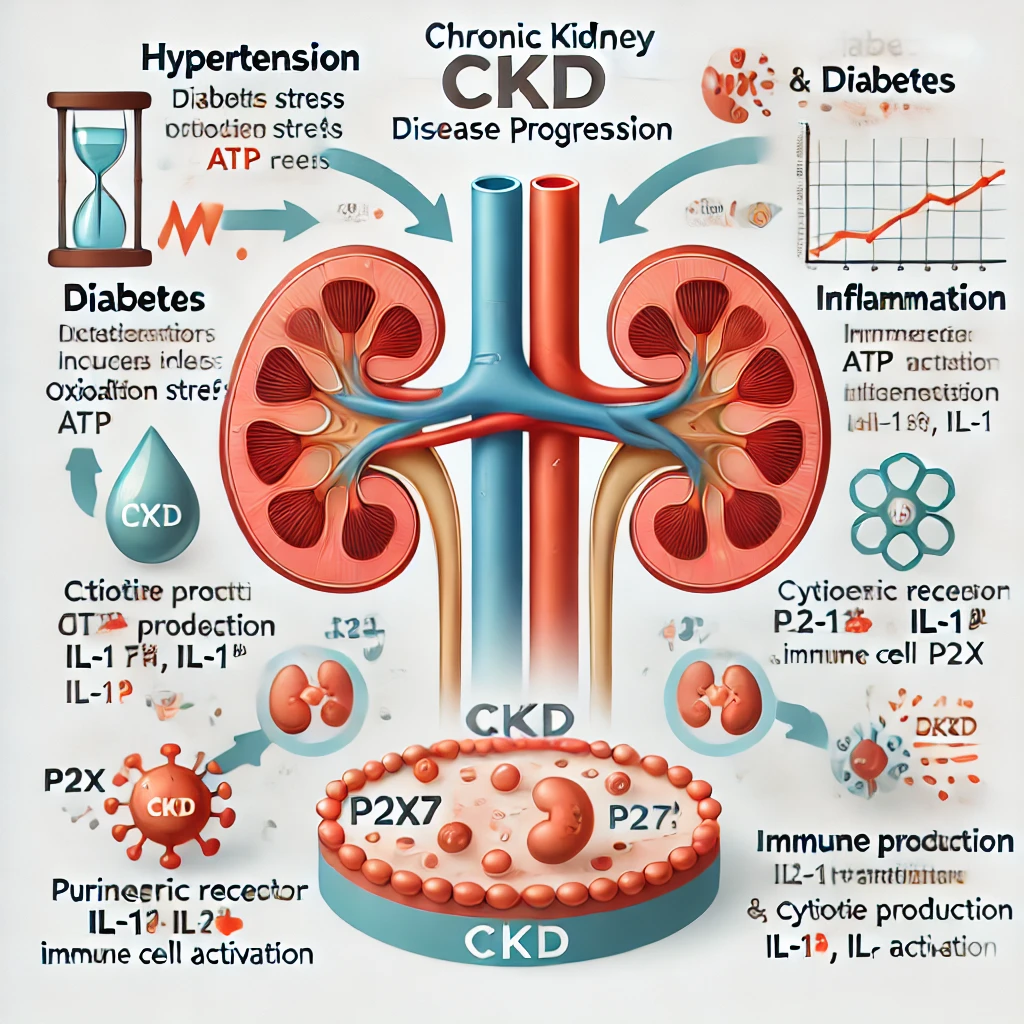A New Therapeutic Mechanism for Chronic Kidney Disease (CKD) Discovered: The Role of Purinergic Receptor P2X7


1. What is the P2X7 Receptor?
The Purinergic receptor P2X7 (P2X7) is an ionotropic purinergic receptor activated by adenosine triphosphate (ATP). It regulates the influx of calcium (Ca²⁺) and sodium (Na⁺) and the efflux of potassium (K⁺) ions. P2X7 plays a key role in immune cell activation, inflammatory responses, and programmed cell death (necrosis, pyroptosis).
P2X7 is highly expressed in immune cells such as monocytes, macrophages, and microglia, making it a crucial factor in inflammation and tissue damage.
Origin of the Name P2X7:
- “P2”: Indicates that it is a purinergic receptor that mediates ATP signaling.
- “X”: Denotes that it functions as an ion channel.
- “7”: Represents the seventh member of the P2X receptor family.
P2X7 is activated particularly in conditions with high extracellular ATP, which occurs in response to cell damage and necrosis. Once ATP binds to P2X7, it opens its ion channel, leading to the release of inflammatory cytokines (IL-1α, IL-1β, TNF-α) and triggering immune responses that exacerbate inflammation.
2. Why is P2X7 Expression Increased in CKD Monocytes?
Studies have shown that P2X7 expression is elevated in the peripheral blood mononuclear cells (PBMCs) of CKD patients. The reasons for this upregulation include:
✅ (1) Chronic Inflammation
- CKD is characterized by persistent inflammation, with increased levels of IL-1α, IL-1β, TNF-α, and IL-6.
- Since P2X7 is a key regulator of inflammation, its expression tends to increase in a pro-inflammatory environment.
✅ (2) Increased ATP Release
- CKD patients experience frequent cellular damage and necrosis, which leads to the release of extracellular ATP.
- ATP is the primary ligand for P2X7, meaning that higher extracellular ATP levels can lead to increased P2X7 expression and activation.
✅ (3) Decline in Kidney Function and Immune Cell Activation
- CKD is associated with progressive loss of kidney function, leading to uremia, which further activates immune cells.
- Activated monocytes and macrophages exhibit higher P2X7 expression, amplifying inflammatory processes.
✅ (4) Oxidative Stress
- CKD is linked to elevated mitochondrial reactive oxygen species (ROS) production, which plays a significant role in P2X7 activation.
- Research suggests that P2X7 activation further increases mitochondrial ROS, promoting IL-1α release and amplifying inflammation.
📌 Conclusion: The increased expression of P2X7 in CKD monocytes results from a combination of chronic inflammation, elevated extracellular ATP, declining kidney function, and oxidative stress.
- Genetic deletion of P2X7 reduces macrophage Ca²⁺ influx and immune cell infiltration into the kidney during chronic kidney injury.
- P2X7⁻/⁻ mice have significantly less fibrosis and inflammation in response to adenine diet-induced CKD.
- P2X7 plays a crucial role in ATP-driven immune activation in CKD, making it a potential therapeutic target for reducing inflammation and fibrosis.
3. Do Hypertension and Diabetes Also Activate P2X7?
✅ (1) Hypertension and P2X7 Activation
- Hypertension induces vascular damage and inflammation, which can worsen CKD.
- Damaged vascular cells release ATP, which can activate P2X7 and amplify inflammatory signaling.
- Studies have shown that calcium influx through P2X7 increases in hypertensive conditions, leading to renal fibrosis and worsening kidney function.
✅ (2) Diabetes and P2X7 Activation
- Diabetes causes hyperglycemia, which leads to oxidative stress and kidney cell damage.
- In hyperglycemic conditions, ATP release increases, leading to higher P2X7 activation.
- Activated P2X7 triggers the release of inflammatory cytokines (IL-1α, IL-1β, TNF-α), contributing to diabetic nephropathy and accelerating kidney damage.
✅ (3) The Link Between Hypertension, Diabetes, and P2X7 Activation
- Both hypertension and diabetes are known to increase inflammation and P2X7 activation.
- Chronic inflammation leads to sustained P2X7 activation, which accelerates CKD progression.
- CKD patients with both hypertension and diabetes show even higher P2X7 expression, potentially worsening disease outcomes.
4. How Does P2X7 Regulate IL-1α-Mediated Inflammation in CKD?
The Mechanism of P2X7-Driven IL-1α Inflammation in CKD:
1️⃣ Increased ATP levels in CKD → Activation of P2X7
2️⃣ P2X7 activation → Ca²⁺ influx → Mitochondrial ROS production
3️⃣ Increased ROS → Enhanced IL-1α release
4️⃣ Elevated IL-1α → Increased immune cell activation → Exacerbation of inflammation
✅ Conclusion: In CKD, the ATP-P2X7-ROS-IL-1α pathway remains persistently activated, leading to ongoing inflammation and fibrosis. Targeting P2X7 could provide a novel therapeutic strategy for CKD.
📌 Final Summary
✔ P2X7 is an ATP-activated ionotropic purinergic receptor that plays a crucial role in inflammation and kidney damage.
✔ CKD patients show increased P2X7 expression due to chronic inflammation, extracellular ATP release, oxidative stress, and immune cell activation.
✔ Hypertension and diabetes further activate P2X7, accelerating CKD progression by promoting inflammation and renal fibrosis.
✔ P2X7 activation enhances IL-1α-mediated inflammation, contributing to CKD deterioration.
✔ P2X7 inhibitors represent a promising new therapeutic target for CKD treatment.
📌 By understanding and targeting the P2X7 signaling pathway, researchers can develop novel therapies to mitigate CKD progression and improve patient outcomes.
Highly Pathogenic Avian Influenza A(H5N1): Recent Human Infection Cases and Prevention Strategies
Recent Posts
How to Read Your Blood Test Results: A Guide for Kidney Disease Management
When managing chronic kidney disease (CKD), regular blood tests are essential. Blood test results help…
How to Follow a Low-Potassium Diet?
Potassium is an essential mineral that helps regulate heart function and muscle contractions. However, for…
How Can Kidney Disease Patients Exercise Safely in the Summer?
Summer’s high temperatures and humidity significantly increase the risk of dehydration and heat-related illnesses during…
5 Essential Principles for Accurate Blood Pressure Measurement – Including Real-Life Cases and Nighttime Hypertension
Why Is Accurate Blood Pressure Measurement Important? Blood pressure (BP) is a vital, dynamic health…
Hypertension: The Silent Killer That Destroys Your Kidneys
Introduction Hypertension is often called the “silent killer.” Without obvious symptoms, it gradually damages major…
A Gene-Edited Pig Kidney in a Human — A Medical Miracle Becomes Reality
🐷 A Pig’s Kidney in a Human Body? Sounds like science fiction — but in…